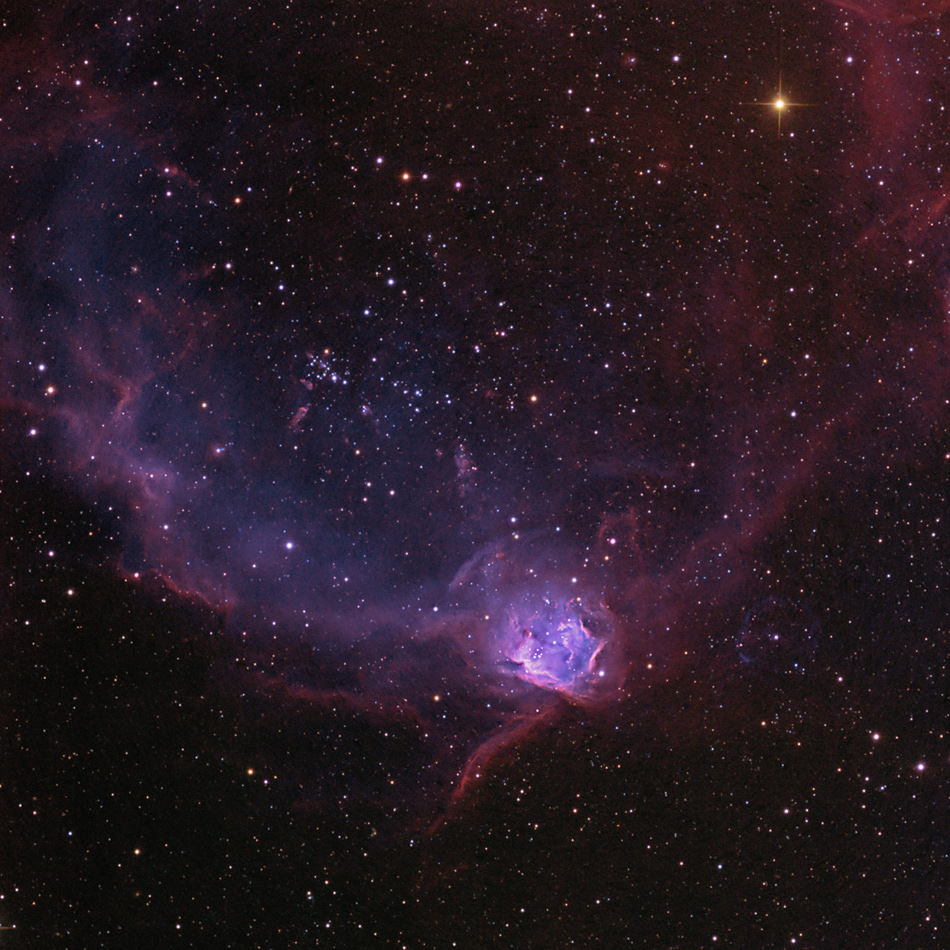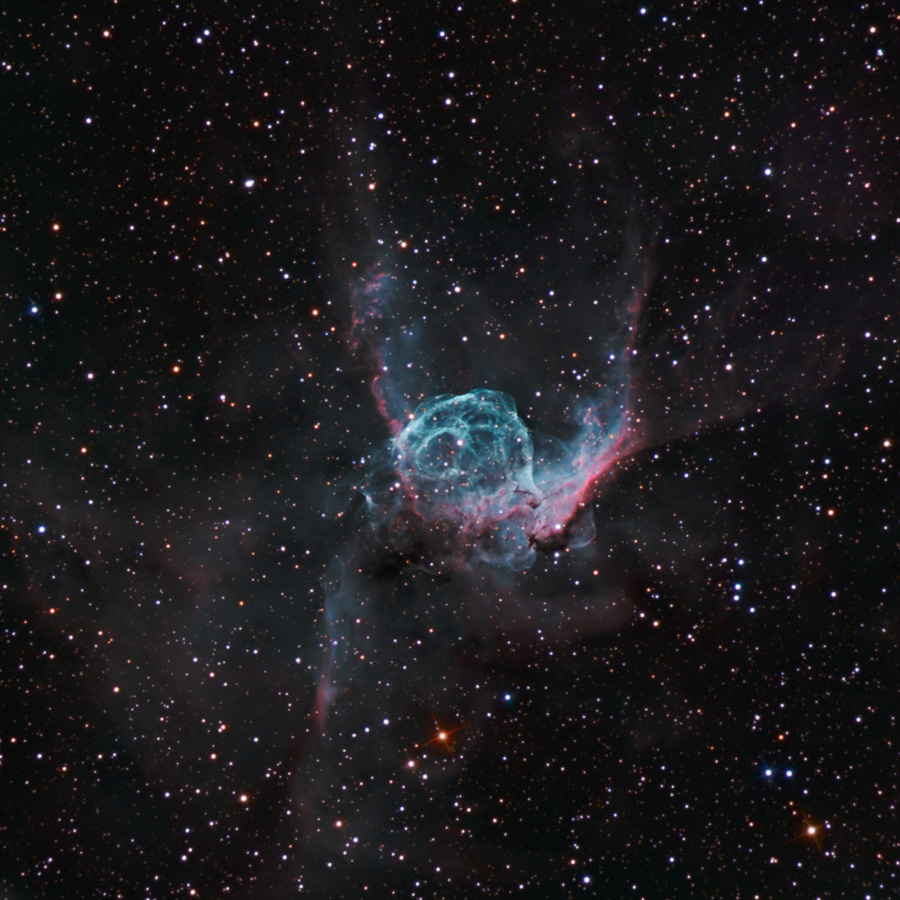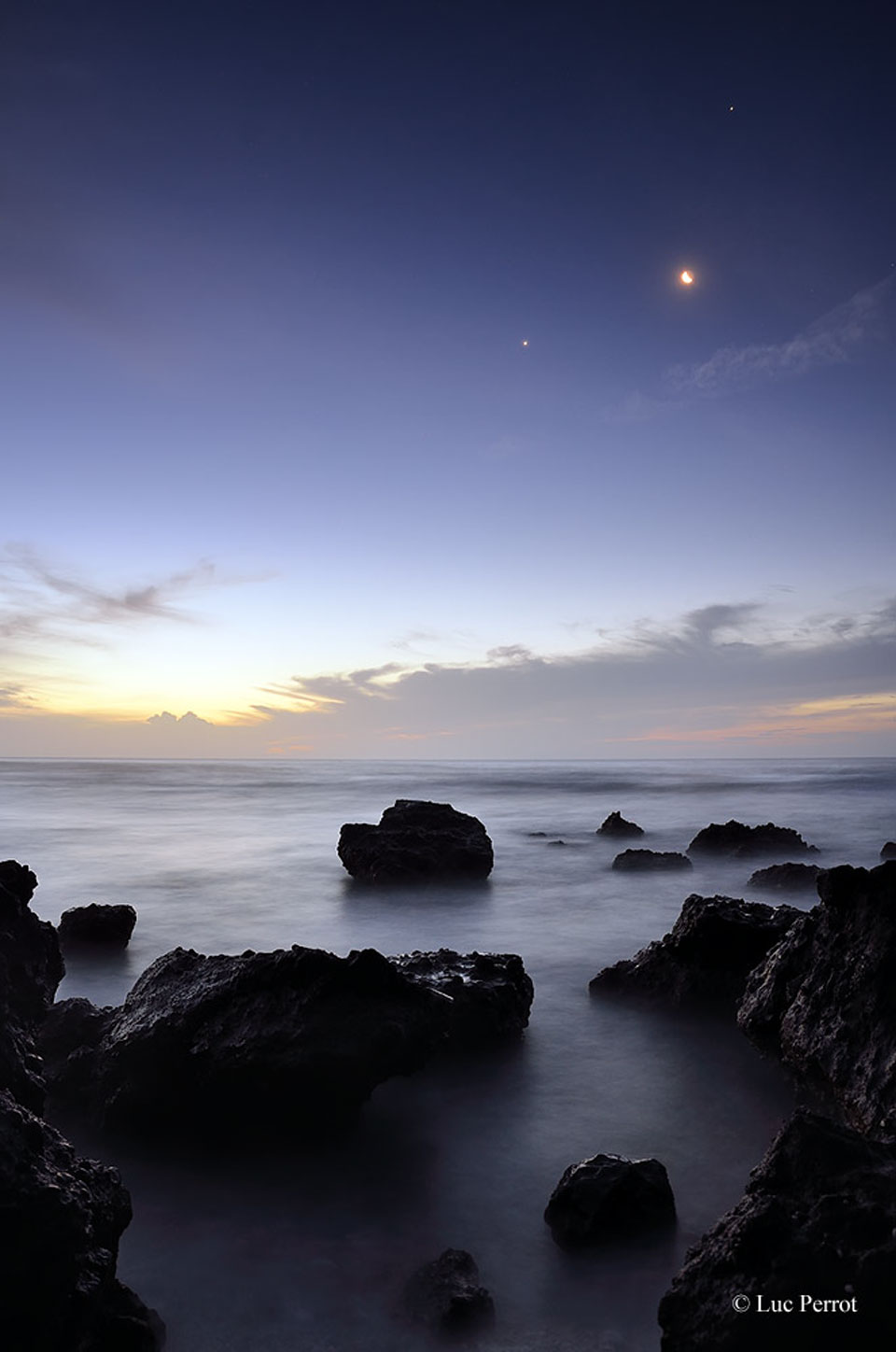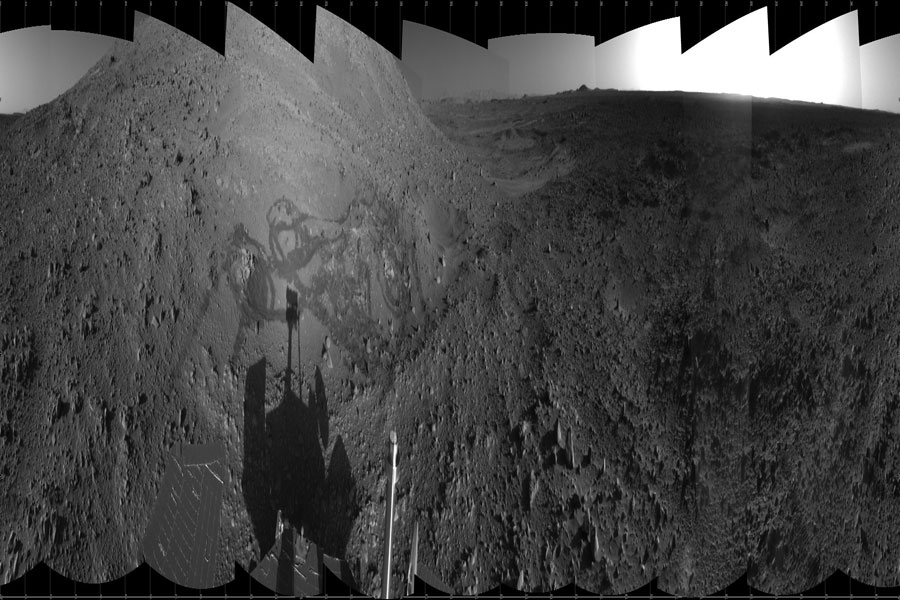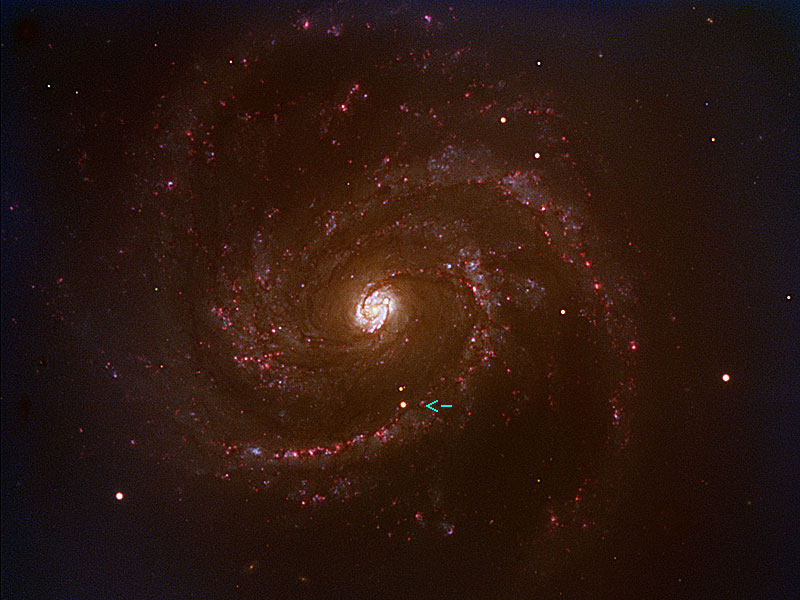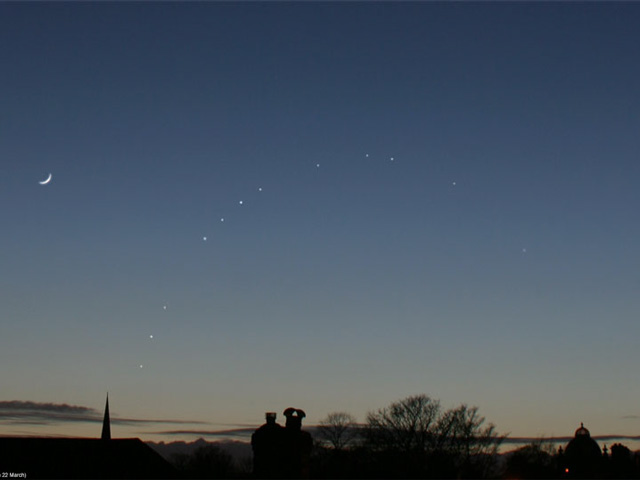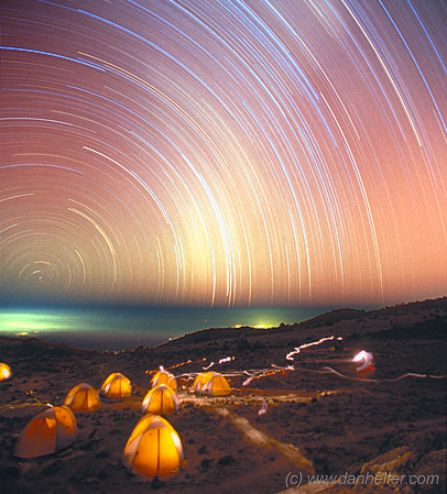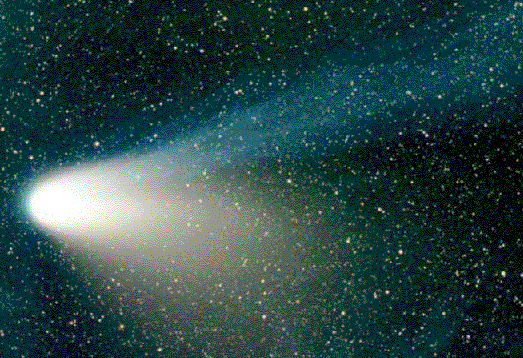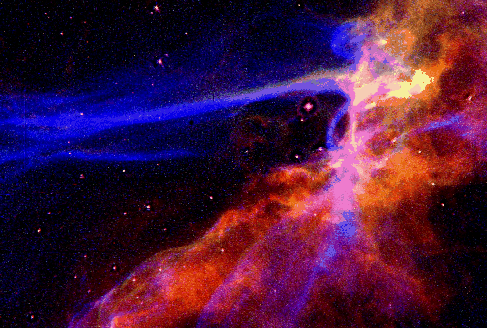| << Previous | Index | Next >> |
2015 Near the outskirts of the Small Magellanic Cloud, a satellite galaxy some 200 thousand light-years distant, lies 5 million year young star cluster NGC 602. Surrounded by natal gas and dust, NGC 602 is just below center in this telescopic field of view with the angular size of the Full Moon on the sky. The cluster itself is about 200 light-years in diameter. Glowing interior ridges and swept back shapes strongly suggest that energetic radiation and shock waves from NGC 602's massive young stars have eroded the dusty material and triggered a progression of star formation moving away from the cluster's center. Of course, the more extended wings of emission in the region suggest a popular name for the complex cosmic environment, The Flying Lizard Nebula.
2014 Brilliant Venus and the central Milky Way rise in the early morning hours of March 1 in this sea and skyscape. The scene looks out from a beach at Sea Isle City, New Jersey, USA, planet Earth. Of course, Earth orbits well within the solar system's habitable zone, that Goldilocks region not too close and not too far from the Sun where surface temperatures can support liquid water. Similar in size to Earth, Venus lies just beyond the inner boundary of the habitable zone. The watery reflection of light from our inhospitable sister planet is seen along a calm, cold ocean and low cloud bank.
2013 This helmet-shaped cosmic cloud with wing-like appendages is popularly called Thor's Helmet. Heroically sized even for a Norse god, Thor's Helmet is about 30 light-years across. In fact, the helmet is actually more like an interstellar bubble, blown as a fast wind from the bright, massive star near the bubble's center sweeps through a surrounding molecular cloud. Known as a Wolf-Rayet star, the central star is an extremely hot giant thought to be in a brief, pre-supernova stage of evolution. Cataloged as NGC 2359, the nebula is located about 15,000 light-years away in the constellation Canis Major. The sharp image, made using broadband and narrowband filters, captures striking details of the nebula's filamentary structures. It shows off a blue-green color from strong emission due to oxygen atoms in the glowing gas.
2012 You don't have to be on Reunion Island to see this week's planetary conjunction. Only if you want to see this picturesque seascape as well. To see the conjunction from just about anywhere in the world, look to the west after sunset. The first planet you may notice is Venus, the brightest object in the western sky. Above Venus, the second brightest object is Jupiter. The hardest planet to spot is Mercury, which is visible only briefly after sunset as a faint dot just above the horizon. Picturesque rocks leading out from Reunion Island to the Indian Ocean populate the foreground of the above picture. Taken last week, the distant planets Venus and Jupiter were joined by a bright crescent Moon, which has now moved away.
2011
Click to play embedded YouTube video.
Credit: NASA/Goddard/SDO AIA Team
2010 Is it art? If so, the paintbrush was the Spirit robotic rover, the canvas was the soil on Mars, and the artists were the scientists and engineers of the Mars Exploration Rover Mission. This panoramic picture, created in 2004 and shown above compressed horizontally, was mostly unintentional -- the MERS team was primarily instructing Spirit to investigate rocks in and around Hank's Hollow in a location called Engineering Flats on Mars. After creating the ground display with its treads, the Spirit rover was instructed to photograph the area along with itself in shadow. In 2010 as winter approaches in northern Mars, Spirit, still mired in sand, has been placed in an energy saving "hibernating" mode until spring arrives and more direct sunlight might be used to power the robotic explorer.
2009 Now fading in our night sky, Comet Lulin has provided some lovely cosmic vistas. Moving rapidly against the background of stars, Lulin briefly posed with the likes of Saturn, and Regulus (Alpha Leo). But here it is seen against a field of distant galaxies. To reveal the faint background galaxies and trace the comet's fading tail, the remarkable picture is a blended composite of telescopic exposures aligned with the both the stars and the speedy comet. The largest galaxies seen left of the comet's head or coma are cataloged as NGC 3016, NGC 3019, NGC 3020 and NGC 3024 and lie at a distance of 100 million light-years or so. When the exposures were made, on February 28, the comet was about 3.6 light-minutes from Earth.
2008 Still gracing northern skies, a fading Comet Holmes lies at the top edge of this colorful skyview, recorded on March 4. The reddish emission nebula below it is NGC 1499, also known as the California Nebula for its resemblance to the outline of the state on the US west coast. Of course, the two cosmic clouds by chance lie along nearly the same line-of-sight and so only appear to be close together and of similar size. The California Nebula is actually about 100 light-years long and 1,500 light-years away, drifting through the Orion Arm of our spiral Milky Way Galaxy. Comet Holmes is about 20 light-seconds in diameter, sweeping through our solar system a mere 25 light-minutes away, beyond the orbit of Mars. The molecules of the comet's gaseous coma fluoresce in sunlight. The California Nebula's glow is characteristic of hydrogen atoms recombining with long lost electrons, originally stripped away (ionized) by ultraviolet starlight. Providing the energetic starlight is Xi Persei, the prominent star below the nebula.
2007 A new spacecraft is headed for the outer Solar System. Named New Horizons, this robotic explorer passed Jupiter last week after being launched only in early 2006. New Horizons is being pulled by Jupiter's gravity to a greater speed toward its next target: Pluto in 2015. During its encounter with Jupiter, New Horizons was able to capture new images of many Jovian moons, Jupiter's complex and ever-changing atmosphere, and Jupiter's Little Red Spot, pictured above. Formed over the past few years from several smaller storms, Jupiter's Little Red Spot survived a near miss with Jupiter's better-known Great Red Spot last year. The above image of Jupiter covers over twice the diameter of the Earth.
2006 One of the nearer supernovas of recent years was discovered last month in the bright nearby galaxy M100. The supernova, dubbed SN 2006X, is still near its maximum brightness and visible with a telescope toward the constellation of Berenice's Hair (Coma Berenices) The supernova, pictured above, has been identified as Type Ia indicating that a white dwarf star in the picturesque spiral galaxy has gone near its Chandrasekhar limit and exploded. Although hundreds of supernovas are now discovered each year by automated searches, nearby supernova are rare and important because they frequently become bright enough to be studied by many telescopes and are near enough for their immediate surroundings to be spatially resolved. Supernova 2006X's host galaxy M100 resides in the Virgo Cluster of Galaxies located about 50 million light years from Earth.
2005 Have you ever seen the planet Mercury? This week might be a good time. Because Mercury orbits so close to the Sun, it never wanders far from the Sun in Earth's sky. If trailing the Sun, Mercury will be visible low on the horizon for only a short while after sunset. If leading the Sun, Mercury will be visible only shortly before sunrise. So at certain times of the year an informed skygazer with a little determination can usually pick Mercury out from a site with an clear horizon. Above, a lot of determination has been combined with a little digital trickery to show Mercury's successive positions during March of 2004. Each picture was taken from the same location in Leeds, England exactly 33 minutes after sunset. Over the next two weeks, Mercury will again be well placed for viewing above the western horizon at sunset, but by the third week in March it will have faded and dropped into the twilight.
2004 No one knows for sure what caused this signal. There is a slight possibility that it just might originate from an extraterrestrial intelligence. The bright colors on the blue background indicate that an anomalous signal was received here on Earth by a radio telescope involved in a Search for Extraterrestrial Intelligence (SETI). A search for these signals is ongoing by several groups including volunteer members of the SETI League. Time labels the vertical axis of the above plot, and frequency marks the horizontal axis. Although this strong signal was never positively identified, astronomers have identified in it many attributes characteristic of a more mundane and ultimately terrestrial origin. In this case, a leading possibility is that the signal originates from an unusual modulation between a GPS satellite and an unidentified Earth-based source. Many unusual signals from space remain unidentified. No signal has yet been strong enough or run long enough to be unambiguously identified as originating from an extraterrestrial intelligence.
2003 The night had no moon, but the stars were out. And camped at 16,000 feet on Mt. Kilimanjaro, photographer Dan Heller recorded this marvelous 3 1/2 hour long exposure. Here the landscape is lit mostly by the stars. Flashlights give the tents an erie internal radiance while the greenish glow from the distant city lights of Moshi, Tanzania filter through the clouds below. The view from this famous equatorial African mountain is toward the south, putting the South Celestial Pole close to the horizon on the far left, near the center of the graceful concentric star trail arcs. In the thin air and clear dark skies, even the ghostly Milky Way left a faint triangular glow as it swept across the middle of the dreamlike scene.
2002 In the last week, Comet Ikeya-Zhang has become bright enough to be just visible to the unaided eye. Based on its present activity, observers are optimistic that Ikeya-Zhang will become substantially brighter. This composite color image from March 3rd, captured with a wide-field telescope, shows this active comet's bright, condensed coma and a delightful array of subtle structures in its developing tail. The bluish tail stretches for 5 degrees or so against a background of stars in the constellation Pisces. In the coming days look for the comet hanging low in the western evening sky (below a bright yellowish Mars), eventually becoming difficult to see in the March twilight. But after April begins, Ikeya-Zhang will become a predawn object climbing higher into the morning sky as the month progresses. Cataloged as comet C/2002 C1, improved orbit determinations now make it seem very likely that Comet Ikeya-Zhang has been around here before. Refined calculations indicate this comet's last trip through the inner Solar System was 341 years ago, in 1661, when it was recorded as a bright comet.
2001 From a spectacular vantage point over 1.4 billion kilometers from the sun, the Voyager 1 spacecraft looked back toward the inner solar system to record this startling view of Saturn's nightside. The picture was taken on November 16, 1980, some four days after the robot spacecraft's closest approach to the gorgeous gas giant. The crescent planet casts a broad shadow across its bright rings while the translucent rings themselves can be seen to cast a shadow on Saturn's cloud tops. Since Earth is closer to the sun than Saturn, only Saturn's dayside is visible to Earth-bound telescopes which could never take a picture like this one. After this successful flyby two decades ago, Voyager 1 has continued outward bound and is presently humanity's most distant spacecraft. The next spacecraft to approach Saturn will be Cassini, on course to arrive in 2004.
2000 The Galileo orbiter's flyby of Io last November captured an unusual part of Jupiter's volcanic moon. From 26,000 kilometers away, Zal Patera was found to be a cauldron of flowing lava, gaseous vents, and tremendous peaks. Red lava can be seen in the above picture erupting along the base of the volcanic caldera, while cooling black lava lines the edge of a volcanic plateau. Shadow lengths indicate that the top of Zal Patera towers nearly 5 kilometers over Io's molten surface. Galileo zoomed past Io again last month, and has begun beaming back images taken only 200 kilometers over Io's surface.
1999 How often do stars explode? By looking at external galaxies, astronomers can guess that these events, known as a supernovae, should occur about once every 30 years in a typical spiral galaxy like our MilkyWay. However, the obscuring gas and dust in the disk of our galaxy probably prevents us from seeing many galactic supernovae -- making observations of these events in our own galaxy relatively rare. In fact, in 1572, the revered Danish astronomer, Tycho Brahe, witnessed one of the last to be seen. The remnant of this explosion is still visible today as the shockwave it generated continues to expand into the gas and dust between the stars.Above is an image of the X-rays emitted by this shockwave made by a telescope onboard the ROSAT spacecraft. The nebula is known as Tycho's Supernova Remnant.
1998 Globular clusters once ruled the Milky Way. Back in the old days, back when our Galaxy first formed, perhaps thousands of globular clusters roamed our Galaxy. Today, there are perhaps 200 left. Many globular clusters were destroyed over the eons by repeated fateful encounters with each other or the Galactic center. Surviving relics are older than any earth fossil, older than any other structures in our Galaxy, and limit the universe itself in raw age. There are few, if any, young globular clusters in our Milky Way Galaxy because conditions are not ripe for more to form. But things are different next door - in the neighboring LMC galaxy. Pictured above is a "young" globular cluster residing there: NGC 1818. Recent observations show it formed only about 40 million years ago - just yesterday compared to the 12 billion year ages of globular clusters in our own Milky Way.
1997 You no longer have to wake-up early to see Comet Hale-Bopp. From many northern locations, you can now go outside just after sunset and see Comet Hale-Bopp above the north-western horizon. Both writer/editors of APOD are impressed by how bright Comet Hale-Bopp has become, and how easily visible it is. The central coma is now visible from almost any location - even from a bright city. The blue ion tale is visible from a dark location. Comet Hale-Bopp's coma now rivals even last year's Comet Hyakutake, and the tail appears to be increasing in length daily.
1996 A supernova explosion of a high-mass star results in fast moving blast waves. At the front of the waves shown above, ionized gas in the Veil Supernova Remnant rushes out from the explosion, sweeps up material, and breaks up many atoms into constituent ions and electrons. Observations with the Hubble Space Telescope in 1993 indicate that the blue shock wave was catapult away from the stellar explosion after the red shock wave and has yet to catch up to it in some regions. The Veil supernova remnant's has a very large angular size - six times the diameter of the full moon - and different parts of it are known as the "Cygnus Loop" and catalog numbers NGC 6960, NGC 6979, NGC 6992, and NGC 6995.
| << Previous | Index | Next >> |
